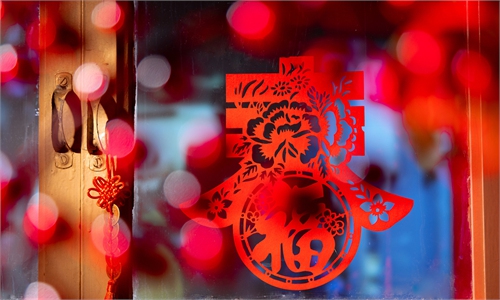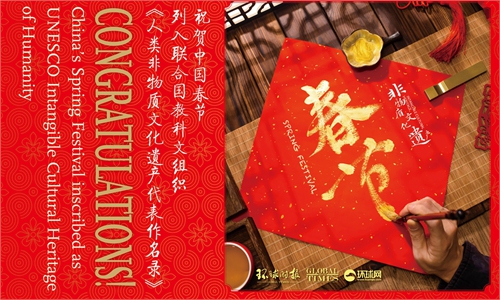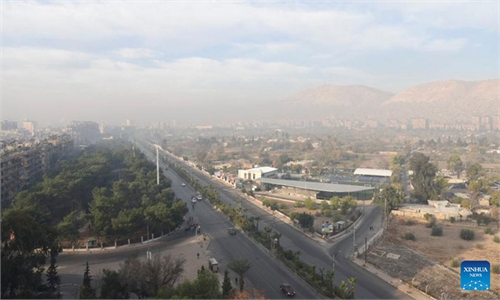A new layer of unique significance is attached to Spring Festival
The Spring Festival's inscription can appropriately be described as "well-earned." The Spring Festival is not only a collection of Chinese folk culture filled with the quintessence of Chinese culture, but also a unique spiritual and emotional code of the Chinese nation. Whether it is the poetic verses "In the sound of firecrackers an old year is gone" or "New charm will always replace the one that's worn," it is full of the ceremonial sense of saying goodbye to the old year and welcoming the new one. One of the aspects of the Spring Festival that is significant to Chinese society and to the safeguarding of UNESCO Intangible Cultural Heritage around the world is that it is a good example of how traditional culture and social development can complement each other. As the text of China's application to UNESCO emphasizes, celebrating the Spring Festival provides "a sense of identity and continuity for the Chinese people." Regarding the Spring Festival, China has seen the largest cyclical migration in human history over the past few decades, as it has transformed from an agricultural to an industrial country. The traditional culture represented by the Spring Festival has become an internal dynamic and a representational form of Chinese modernization.
Pursuits such as "family reunion" and "going back home for the Spring Festival" essentially embody the resilience and perseverance of the Chinese people, as well as the aspiration and pursuit of a better life. In addition to personal happiness, this extends to the concepts and values of family harmony, national prosperity and world peace. This is also the reason why the Spring Festival is a cultural symbol that resonates with the world. It is consistent with the global hope for peace and harmony, providing inspiration for solving the many dilemmas and problems caused by the realpolitik mind-set of playing zero-sum games where one side must lose if the other wins.
Before being included in the UNESCO Intangible Cultural Heritage list, nearly 20 countries around the world had already designated the Chinese New Year as a public holiday, highlighting the extraordinary influence of Spring Festival culture in a globalization era. Today, approximately one-fifth of the world's population celebrate the Chinese New Year in various forms. Many national leaders visit local Chinese communities and deliver greetings during the festival, demonstrating that as China's international status and influence rise, the global recognition of Chinese culture has also grown. Last December, the United Nations officially designated the Lunar New Year as a UN floating holiday. This shows that the Spring Festival is no longer merely a cultural heritage of China. It has also transcended national and ethnic boundaries to become a cultural symbol that is widely accepted, recognized, and appreciated around the world.
The significance of the Spring Festival's successful inclusion as an Intangible Cultural Heritage of Humanity goes beyond this achievement. As a cultural name card of China, it bridges the diverse cultures and values of East and West. While offering the world a more comprehensive and multidimensional understanding of China, it also fosters cross-cultural understanding and exchange. The world needs more examples of this kind to shape its perception of China. Fortunately, the vast land of China is blessed with a rich history and profound civilization. Many other Intangible Cultural Heritages, like the Spring Festival, which builds bridges between ancient and modern times, the East and the West, are worth exploring, preserving and promoting.
Apart from the Spring Festival's successful inscription, three Chinese heritage projects - traditional Li textile techniques, traditional Chinese wooden arch bridges, and Qiang New Year festival - were transferred from the List of Intangible Cultural Heritage in Need of Urgent Safeguarding to the Representative List of the Intangible Cultural Heritage of Humanity. This signifies that through concerted efforts, these heritage projects have seen fundamental improvements in their preservation status, moving out of the endangered category and establishing a foundation for inheritance and development.
In recent years, China's achievements in cultural heritage protection have been widely recognized. A wealth of systematic practical experience has been accumulated in areas such as government leadership, social participation, and education and inheritance, providing valuable models for other countries to draw upon. From delving into Mayan civilization to studying human origins in Africa and exploring ancient Egyptian civilization, China, together with its Belt and Road partners, has launched over 30 cultural heritage protection projects. These efforts have yielded positive results, adding significant contributions to fostering cultural exchange and mutual learning among civilizations worldwide.
"Delicious soup is made by combining different ingredients." The diversity of civilizations is a fundamental characteristic of human society. While walking on the path to building a community with a shared future for mankind, China is willing to work with countries around the world to promote cultural exchange and mutual learning with a more open and inclusive attitude.
As the latest representative of China's Intangible Cultural Heritage of Humanity, the Spring Festival is now attached with a new layer of unique significance. Rooted in Chinese civilization and integrated into world civilization, it plays an increasingly vital role in fostering dialogue between Chinese and other civilizations in the world. This enables the world to find greater resonance and harmony within its diversity of civilizations.

A new layer of unique significance is attached to Spring Festival
The Spring Festival's inscription can appropriately be described as "well-earned." The Spring Festival is not only a collection of Chinese folk culture filled with the quintessence of Chinese culture, but also a unique spiritual and emotional code of the Chinese nation. Whether it is the poetic verses "In the sound of firecrackers an old year is gone" or "New charm will always replace the one that's worn," it is full of the ceremonial sense of saying goodbye to the old year and welcoming the new one. One of the aspects of the Spring Festival that is significant to Chinese society and to the safeguarding of UNESCO Intangible Cultural Heritage around the world is that it is a good example of how traditional culture and social development can complement each other. As the text of China's application to UNESCO emphasizes, celebrating the Spring Festival provides "a sense of identity and continuity for the Chinese people." Regarding the Spring Festival, China has seen the largest cyclical migration in human history over the past few decades, as it has transformed from an agricultural to an industrial country. The traditional culture represented by the Spring Festival has become an internal dynamic and a representational form of Chinese modernization.
Pursuits such as "family reunion" and "going back home for the Spring Festival" essentially embody the resilience and perseverance of the Chinese people, as well as the aspiration and pursuit of a better life. In addition to personal happiness, this extends to the concepts and values of family harmony, national prosperity and world peace. This is also the reason why the Spring Festival is a cultural symbol that resonates with the world. It is consistent with the global hope for peace and harmony, providing inspiration for solving the many dilemmas and problems caused by the realpolitik mind-set of playing zero-sum games where one side must lose if the other wins.
Before being included in the UNESCO Intangible Cultural Heritage list, nearly 20 countries around the world had already designated the Chinese New Year as a public holiday, highlighting the extraordinary influence of Spring Festival culture in a globalization era. Today, approximately one-fifth of the world's population celebrate the Chinese New Year in various forms. Many national leaders visit local Chinese communities and deliver greetings during the festival, demonstrating that as China's international status and influence rise, the global recognition of Chinese culture has also grown. Last December, the United Nations officially designated the Lunar New Year as a UN floating holiday. This shows that the Spring Festival is no longer merely a cultural heritage of China. It has also transcended national and ethnic boundaries to become a cultural symbol that is widely accepted, recognized, and appreciated around the world.
The significance of the Spring Festival's successful inclusion as an Intangible Cultural Heritage of Humanity goes beyond this achievement. As a cultural name card of China, it bridges the diverse cultures and values of East and West. While offering the world a more comprehensive and multidimensional understanding of China, it also fosters cross-cultural understanding and exchange. The world needs more examples of this kind to shape its perception of China. Fortunately, the vast land of China is blessed with a rich history and profound civilization. Many other Intangible Cultural Heritages, like the Spring Festival, which builds bridges between ancient and modern times, the East and the West, are worth exploring, preserving and promoting.
Apart from the Spring Festival's successful inscription, three Chinese heritage projects - traditional Li textile techniques, traditional Chinese wooden arch bridges, and Qiang New Year festival - were transferred from the List of Intangible Cultural Heritage in Need of Urgent Safeguarding to the Representative List of the Intangible Cultural Heritage of Humanity. This signifies that through concerted efforts, these heritage projects have seen fundamental improvements in their preservation status, moving out of the endangered category and establishing a foundation for inheritance and development.
In recent years, China's achievements in cultural heritage protection have been widely recognized. A wealth of systematic practical experience has been accumulated in areas such as government leadership, social participation, and education and inheritance, providing valuable models for other countries to draw upon. From delving into Mayan civilization to studying human origins in Africa and exploring ancient Egyptian civilization, China, together with its Belt and Road partners, has launched over 30 cultural heritage protection projects. These efforts have yielded positive results, adding significant contributions to fostering cultural exchange and mutual learning among civilizations worldwide.
"Delicious soup is made by combining different ingredients." The diversity of civilizations is a fundamental characteristic of human society. While walking on the path to building a community with a shared future for mankind, China is willing to work with countries around the world to promote cultural exchange and mutual learning with a more open and inclusive attitude.
As the latest representative of China's Intangible Cultural Heritage of Humanity, the Spring Festival is now attached with a new layer of unique significance. Rooted in Chinese civilization and integrated into world civilization, it plays an increasingly vital role in fostering dialogue between Chinese and other civilizations in the world. This enables the world to find greater resonance and harmony within its diversity of civilizations.










